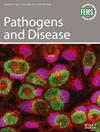Protective Anti-Chlamydial Vaccine Regimen-Induced CD4+ T cell Response Mediates Early Inhibition of Pathogenic CD8+ T cell Response Following Genital Challenge
IF 2.7
4区 医学
Q3 IMMUNOLOGY
引用次数: 0
Abstract
We have demonstrated previously that TNF-α-producing CD8 + T cells mediate chlamydial pathogenesis, likely in an antigen (Ag)-specific fashion. Here we hypothesize that inhibition of Ag-specific CD8 + T cell response after immunization and/or challenge would correlate with protection against oviduct pathology induced by a protective vaccine regimen. Intranasal (i.n.) live chlamydial elementary body (EB), intramuscular (i.m.) live EB, or i.n. irrelevant antigen, bovine serum albumin (BSA), immunized animals induced near-total protection, 50% protection, or no protection, respectively against oviduct pathology following i.vag. C. muridarum challenge. In these models, we evaluated Ag-specific CD8 + T cell cytokine response at various time-periods after immunization or challenge. The results show protective efficacy of vaccine regimens correlated with reduction of Ag-specific CD8 + T cell TNF-α responses following i.vag. chlamydial challenge, not after immunization. Depletion of CD4 + T cells abrogated, whereas adoptive transfer of Ag-specific CD4 + T cells induced the significant reduction of Ag-specific CD8+ T cell TNF- α response after chlamydial challenge. In conclusion, protective anti-chlamydial vaccine regimens induce Ag-specific CD4 + T cell response that mediate early inhibition of pathogenic CD8 + T cell response following challenge and may serve as a predictive biomarker of protection against Chlamydia -induced chronic pathologies.保护性抗衣原体疫苗方案诱导的 CD4+ T 细胞反应介导生殖器挑战后致病性 CD8+ T 细胞反应的早期抑制
我们之前已经证明,产生 TNF-α 的 CD8 + T 细胞介导衣原体的发病机制,很可能是以抗原(Ag)特异性的方式介导的。在此,我们假设在免疫和/或挑战后抑制Ag特异性CD8 + T细胞反应将与保护性疫苗方案诱导的输卵管病理学保护相关。经鼻内(i.n.)活衣原体原体(EB)、肌肉注射(i.m.)活EB或i.n.无关抗原牛血清白蛋白(BSA)免疫的动物在经鼻内(i.vag.)活衣原体原体(EB)、肌肉注射(i.m.)活EB或i.n.无关抗原牛血清白蛋白(BSA)免疫的动物在经鼻内(i.vag.在这些模型中,我们评估了Ag.在这些模型中,我们评估了免疫或挑战后不同时间段的蚕特异性 CD8 + T 细胞细胞因子反应。结果表明,疫苗方案的保护效力与经阴道衣原体挑战后而非免疫接种后Ag特异性CD8 + T细胞TNF-α反应的减少有关。CD4+T细胞的耗竭会减弱衣原体挑战后Ag特异性CD4+T细胞的TNF-α反应,而Ag特异性CD8+T细胞的采用性转移则会诱导Ag特异性CD4+T细胞TNF-α反应的显著降低。总之,保护性抗衣原体疫苗方案可诱导琼脂特异性 CD4 + T 细胞反应,介导挑战后致病性 CD8 + T 细胞反应的早期抑制,并可作为预防衣原体诱导的慢性病变的预测性生物标志物。
本文章由计算机程序翻译,如有差异,请以英文原文为准。
求助全文
约1分钟内获得全文
求助全文
来源期刊

Pathogens and disease
IMMUNOLOGY-INFECTIOUS DISEASES
CiteScore
7.40
自引率
3.00%
发文量
44
期刊介绍:
Pathogens and Disease publishes outstanding primary research on hypothesis- and discovery-driven studies on pathogens, host-pathogen interactions, host response to infection and their molecular and cellular correlates. It covers all pathogens – eukaryotes, prokaryotes, and viruses – and includes zoonotic pathogens and experimental translational applications.
 求助内容:
求助内容: 应助结果提醒方式:
应助结果提醒方式:


